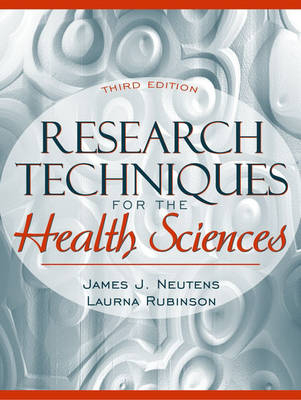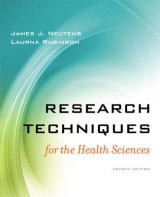
Research Techniques for the Health Sciences
Pearson (Verlag)
978-0-205-34096-5 (ISBN)
- Titel erscheint in neuer Auflage
- Artikel merken
Research Techniques for the Health Sciences focuses on pragmatic aspects of health science research. Underlying concepts and theory are explained and illustrated through a common-sense approach utilizing case studies.
All of the text's case studies are health-oriented in school, community, and hospital settings involving students, teachers, physicians, nurses, and health science researchers. New to this edition is an emphasis on online research, an Evidence Based Health Care approach to literature review derived from Evidence Based Medicine, and a reorganization of content presentation. These features allow students to dive into the research process sooner and approach ethical concerns within a more informed context.
Most chapters begin with a Case Study and end with a Case Discussion, as well as a Summary, and Suggested Activities.
1. What is Research?
Health Science Research.
Using Science in the Quest for Knowledge.
2. Developing the Research Proposal.
Selection of the Problem.
Sources of Problems.
Statement of the Problem and Research Questions.
Subproblems.
Components Comprising the Setting of the Problem.
Formulation of Hypotheses.
Significance and Justification of the Problem.
Resume of Related Literature.
Proposed Research Procedures.
Budget Considerations.
Time Schedule.
Research Proposal Checklist.
3. Critical Review of the Literature and Information Resources.
Purposes of the Review.
Steps in the Review Process.
Reading Background Information.
Gathering the Necessary Tools.
Listing Key Words.
Selecting Preliminary Sources Including Databases.
Conducting a Computer Search.
Determining What to Read.
Determining the Level of Evidence.
Shortcuts to Evidence Based Data.
The Computer Search.
Writing the Section on Related Literature.
4. Research in an Ethical Context.
General Ethical Dilemmas in Human Research.
Justification to Experiment on Humans.
Vulnerable Target Groups: Children.
Informed Consent: Truthtelling and Deception.
Right to Privacy and Confidentially.
Responsibility for Harmful Consequences.
The Duty to Continue a Successful Research Effort.
Therapeutic and Nontherapeutic Research.
Sponsored Research.
Publication of Unethical Research.
Research or Just a Look-See.
Role of the Institutional Review Board.
5. Conducting Experimental and Quasi-Experimental Research.
Characteristics of Experimentation.
Control in Experiments.
The Hawthorne Effect-Controlling Situations.
Advantages and Disadvantages of the Experimental Method.
Internal and External Validity.
Constructing Experimental Designs to Control Variables.
6. Data Collection through Surveys and Self-Reports.
Characteristics of Survey Research.
Survey Flow Plan.
Survey Design.
Data Collection Methods.
Computer Revolution: Web Based Surveys including Electronic Mail.
Survey Sampling.
Questionnaire Design and Construction.
Cover Letter.
Pretesting and Questionnaire Revision.
Focus Groups.
The Delphi Technique.
7. Sampling Designs and Techniques.
The Purpose of Sampling.
The Sampling Frame.
Sampling Techniques.
Sample Size.
8. Qualitative Research.
Characteristics of Qualitative Research.
Theoretical Foundations.
Techniques of Collecting Qualitative Data.
Analyzing Qualitative Data.
Using Computers in Data Analysis.
9. Evaluation Research.
Introduction.
Purposes of Evaluation Research.
What Can Be Evaluated?
Steps in Conducting Evaluation.
Evaluation Models.
Types of Evaluation Research.
Methodological Approaches to Evaluation Research.
10. Analytic Epidemiologic Studies.
Case 1 Cohort Study.
Case 2 Case Control.
The Nature of Disease Investigation.
Analytic Methodologies in Epidemiology.
Cohort or Prospective Investigations.
Case Control or Retrospective Investigations.
Establishing Causation.
Problems of Error.
Control in Epidemiologic Research.
Analysis of Results in Analytic Epidemiology.
11. Analyzing and Interpreting Data: Descriptive Analysis.
The Meaning of Statistics.
Statistical Analysis and Data.
Descriptive Data Analysis Techniques.
Personal Computers and Information Delivery Systems.
12. Analyzing and Interpreting Data: Inferential Analysis.
Inferential Analysis.
Testing Statistical Significance.
Inferential Data Analysis Techniques.
Nonparametric Tests of Significance.
Advanced Data Analysis Techniques.
Meta-Analysis.
13. Techniques for Data Presentation.
Table Presentations.
Table Format.
Figure Presentations.
Graphics and the Computer.
14. Writing a Research Report.
The Report as a Communication Document.
Preliminaries.
Text or Main Body of the Report.
References.
Appendices.
Writing Style.
Appendix A. Common Statistical Procedures.
Appendix B. World Wide Web Research Information.
| Erscheint lt. Verlag | 14.2.2002 |
|---|---|
| Sprache | englisch |
| Gewicht | 705 g |
| Themenwelt | Medizin / Pharmazie |
| ISBN-10 | 0-205-34096-2 / 0205340962 |
| ISBN-13 | 978-0-205-34096-5 / 9780205340965 |
| Zustand | Neuware |
| Haben Sie eine Frage zum Produkt? |
aus dem Bereich



